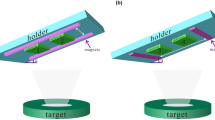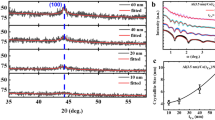Abstract
The Rotating Cryostat system consists of a rapidly rotating, liquid-nitrogen-cooled drum, around which a substrate can be placed. The possibility of using multiport sources gives the system wide capabilities for producing new materials. The effects of various rotation speeds of 1900, 1500, 1000, 500, and 0 rpm on the magnetic properties of thin iron films deposited on different (glass, silicon, and Kapton™) substrates from a resistively heated evaporation source and a dc sputtering source have been investigated. Magnetic measurement showed that the films have an in-plane magnetic anisotropy for all films deposited at high speeds on all types of substrates and the degree of magnetic anisotropy decreased with decreasing rotational speed for flexible Kapton substrate. While the glass and silicon substrates was stationary, in-plane magnetic anisotropy of the films dropped down to zero. The films deposited on Kapton showed the rotational-speed-dependent magnetic properties. Estimation of magnetic anisotropy confirms in-plane anisotropy in the films. Furthermore, as expected for all iron films no magnetic anisotropy perpendicular to film plane was observed irrespective of rotation speed and type of substrate used.
Similar content being viewed by others
REFERENCES
M. Carbucicchio, M. Rateo, G. Ruggiero, and G. Turilli, J. Magn. Magn. Mater. 242–245, 601–603 (2002).
S. Yamashita, J. Yamasaki, M. Ikeda, and N. Iwabuchi, J. Appl. Phys. 70, 6627 (1991).
H. Kockar, Magnetic Material Production Using a Novel Ro-tating Cryostat and Their Magnetic and Structural Anlysis,PhD Thesis (Cardiff University, Cardiff, UK, 1998).
M. Prutton, Thin Ferromagnetic Films (Butterworths, London, 1964).
H. Kockar and T. Meydan, Euro. Phys. J. A, 17(3), 209 (2002).
H. Kockar and T. Meydan, J. Magn. Magn. Mater. 242(P1), 183 (2002).
H. Kockar and T. Meydan, J. Magn. Magn. Mater. 242(P1), 187 (2002).
H. Kockar and T. Meydan, Physica-B, 321(1–4), 124 (2002).
G. Suran, K. Ounadjela, and F. Machizaud, J. Appl. Phys. 61(8), (1987).
P. H. Dionisio, Thin Solid Films 217, 152 (1992).
M. Rivas, J. F. Calleja, and M. C. Contreras, J. Magn. Magn. Mater. 166, 53 (1997).
D. Jiles, Introduction to Magnetism and Magnetic Materials (Chapman and Hall, London, 1991).
Author information
Authors and Affiliations
Rights and permissions
About this article
Cite this article
Kockar, H. Rotation Speed-Induced Uniaxial In-Plane Anisotropy in Thin Films Deposited Onto a Rotating Substrate. Journal of Superconductivity 17, 531–536 (2004). https://doi.org/10.1023/B:JOSC.0000041792.93118.2b
Issue Date:
DOI: https://doi.org/10.1023/B:JOSC.0000041792.93118.2b




